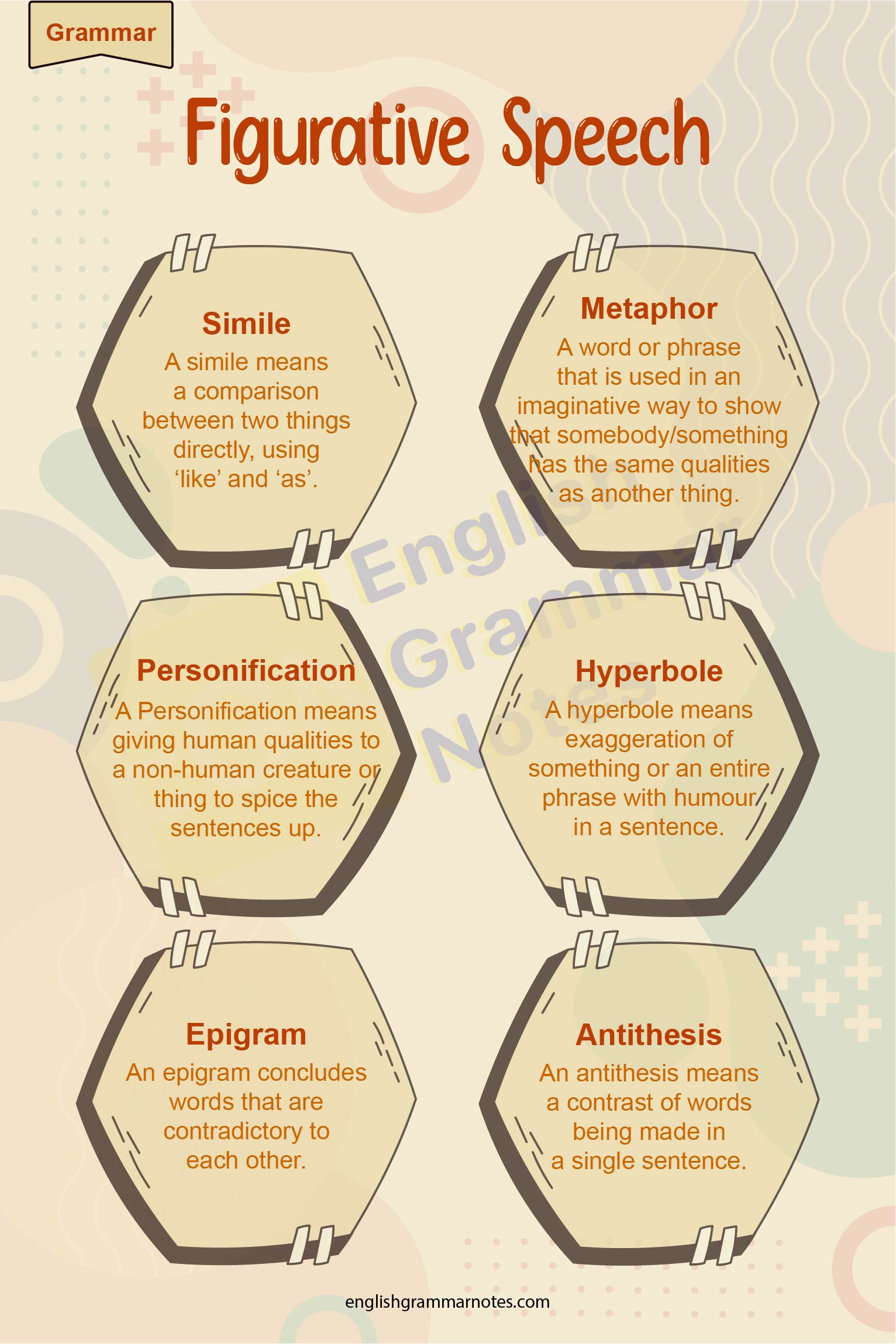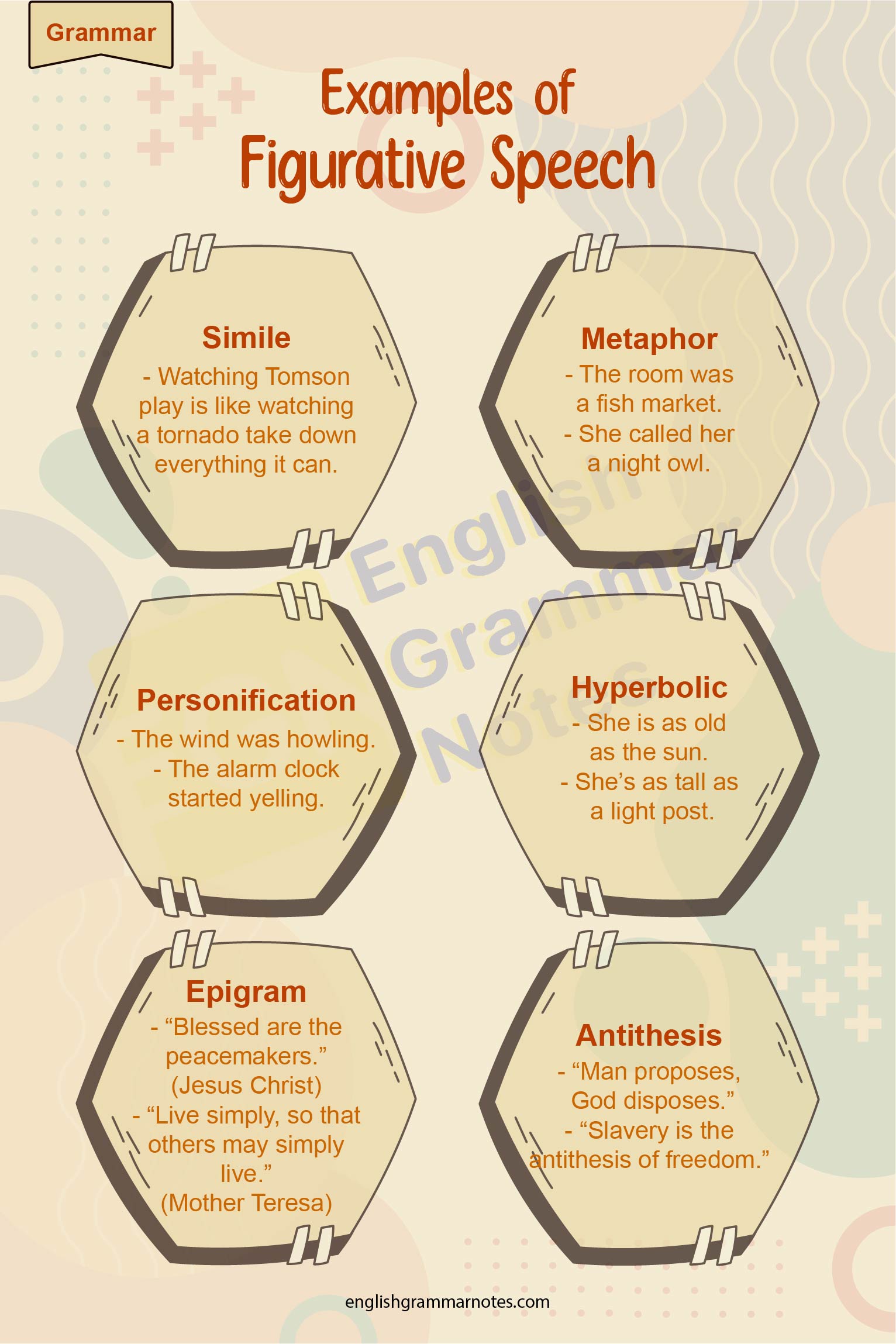Figurative Language: The word comes from the French word Figurative, which means metaphorical. So, figurative language means phrasing the words or the sentences in a way beyond the real meaning to establish a meaning beyond. They are used for colouring up your sentences. They tone your writings.
For understanding it better, one can maintain a figurative language list, as understanding it better plays a vital role in reading.
One can also maintain a sheet of figurative language meanings with examples. We come across a lot of metaphors while reading or doing works related to reading or writing. Sometimes students have to study figurative language. They can do this by making or studying figurative language worksheets. It will help them keep things in mind if they practice the worksheets again and again.
Figure Of Speech in English is words or phrases that change the ordinary language into unique ones. There are almost thirty types. Unfortunately, getting examples for every 30 types are not possible. So, we will discuss the most used Figure of Speech in a Sentence.
Figurative Language List
- Uses of Figurative Language/Figure of Speech
- List of Figurative Language/Figure of Speech
- Description of Figurative Language/Figure of Speech
- Examples of Figurative Language/Figure of Speech
- Uses of Figurative Language in Literature/Figure of Speech
Uses of Figurative Language/Figure of Speech
There are many uses of figurative language. Like,
- In comparing two different ideas for acknowledging the meaning of the one idea.
- Describing the ideas which are difficult in understanding.
- Sometimes helping in making connections.
- It helps a lot in influencing the audience.
- It shows more intense emotions.
- In drawing out the feelings written in words.
- Making everything easier to imagine.
Types of Figurative Language/Figure of Speech
Lots of figurative languages are present therein modern write-ups. Although five of them are the most used, they are Metaphor, Personification, Simile, Symbolism, Hyperbole. We will talk about the most used twenty-five types.
- Simile
- Metaphor
- Alliteration
- Personification
- Symbolism
- Hyperbole
- Idiom
- Metonymy
- Assonance
- Cliché
- Synecdoche
- Onomatopoeia
- Apostrophe
- Transferred Epithets
- Euphemism
- Irony or sarcasm
- Pun
- Epigram
- Antithesis
- Oxymoron
- Litotes
- Interrogation
- Exclamation
- Climax
- Circumlocution
- Tautology
Description of Figurative Language/Figure of Speech
Simile
A simile means a comparison between two things directly, using ‘like’ and ‘as’.
Metaphor
A metaphor means comparing two things, which don’t have to be necessarily similar or alike. But they have to make an imaginary link in the reader’s mind while reading it.
Alliteration
An alliteration means repeating the sound of the first or second word from a series of words or a great sentence. It helps in attracting the reader’s attention.
Personification
A Personification means giving human qualities to a non-human creature or thing to spice the sentences up.
Symbolism
A symbolism means something with an entirely different meaning being used as something that has another meaning. They create magical links in the reader’s mind.
Hyperbole
A hyperbole means exaggeration of something or an entire phrase with humour in a sentence.
Idiom
An idiom means an expression that usually gets used by a particular number of people or a group of people and can only be understood by common uses.
Metonymy
A metonymy means a speech where another word replaces a word with an almost similar meaning or is associated with another.
Assonance
Assonance means repeating vowel sounds in sentences.
Cliché
A cliché means the words or phrases used so many times that they’re meaningless.
Synecdoche
A synecdoche means a type of speech in which a word or two represent an entire meaning. Thus, you can make the readers understand a whole meaning by using one word or two.
Onomatopoeia
An onomatopoeia means words that can imitate the sound that the writer wants the word to make.
Apostrophe
An apostrophe means an address to an inanimate or non-living thing as a living thing or addressing an absent person as if they are present.
Transferred Epithets
A transferred epithet means transferring the objects into something else, and it can be from persons to things or something else.
Euphemism
A euphemism means converting disagreeable or unpleasant events into agreeable and pleasant forms.
Irony or sarcasm
Irony or sarcasm means using a different word to describe something entirely different. The real meaning and the intended meaning are different here.
Epigram
An epigram concludes words that are contradictory to each other.
Antithesis
An antithesis means a contrast of words being made in a single sentence.

Oxymoron
An oxymoron means a combination of two contradictions to create a sharper effect.
Litotes
A litotes means conveying an affirmative by negations of the opposites. It is the exact opposite of Hyperbole.
Interrogation
An interrogation means agreeing or denying something strongly, more than the ordinary language.
Exclamation
An exclamation means sentences which we use to express strong emotions.
Climax
A climax means a series of ideas which we use to increase the importance of specific things.
Circumlocution
A circumlocution means expressing ideas in roundabout ways.
Tautology
A tautology means repeating the same things in different words or ways.
Examples of Figurative Language/Figure of Speech
Simile
- She was as brave as a tigress.
- Watching Tomson play is like watching a tornado take down everything it can.
Metaphor
- The room was a fish market.
- She called her a night owl.
Alliteration
- Go and gather the green leaves and the grapes.
- Rama started running right when she realised she was running round and round.
Personification
- The wind was howling.
- The alarm clock started yelling.
Symbolism
- Saffron, white and green symbolises Indian patriotism.
- Rupee symbolises Indian money.
Hyperbolic
- She is as old as the sun.
- She’s as tall as a light post.
Idiom
- Burn your bridges (Doing something in a way that it makes impossible to go back to its natural form.)
- Left out (Being ignored.)
Metonymy
- Heart (To refer to all the emotions)
Example: You have all my heart.
- Dish (To refer an entire plate full of food items)
Example: She cooks the best Indian dishes.
Assonance
- Dumb luck.
- Good night, sleep tight.
Cliché
- All that glitters is not diamond.
- Read between the lines.
Synecdoche
- We commonly refer to cow milk when we use ‘milk’ where there are other milk sources, like goat milk and coconut milk.
- We refer to almost every cold drink commonly when we use ‘coke’ with a specific brand name.
Onomatopoeia
- Dribble (Water sound)
- (Laughter sound)
Apostrophe
- I’m planning to own a farmhouse someday.
- Oh, my lord!
Transferred Epithets
- Sleepless nights.
- Suicidal clouds.
Euphemism
- Passed away.
- Putting down.
Irony or sarcasm
- A pilot was frightened of heights.
- “Do you want help?”
-“No, thanks.”
Epigram
- “Blessed are the peacemakers.” (Jesus Christ)
- “Live simply, so that others may simply live.” (Mother Teresa)
Antithesis
- “Man proposes, God disposes.”
- “Slavery is the antithesis of freedom.”

Oxymoron
- Open secret.
- Good.
Litotes
- Not unlike.
- It’s not the cheapest.
Interrogation
- A homeschool inspection is not an interrogation.
- We will find him and take him for interrogation.
Exclamation
- We can’t wait to go to the museum!
- That news story made them so sad!
Climax
- To infinity and beyond!
- If I think it’s bad, it just gets worse.
Circumlocution
- Holy mother of Jesus!
- What the hell!
Tautology
- It was like déjà vu there.
- Our nation should come together to unite.
Uses of Figurative Language in Literature/Figure of Speech
Simile
“She entered with an ungainly struggle like some huge awkward chicken, torn, squawking, out of its coop.”
(The Adventure of The Three Gables by Sir Arthur Conan Doyle)
Metaphor
“But soft, what light through yonder window breaks? It is the east, and Juliet is the sun!”
(Romeo and Juliet by William Shakespeare)
Alliteration
“And we beseech you, bend you to remain here, in the cheer and comfort of our eye, Our chiefest courtier, cousin, and our son.”
(Hamlet by William Shakespeare)
Personification
“Once there was a tree
And she loved the little boy.
And every day, the boy would come
And he would gather her leaves
And make them into crowns and play king of the forest.”
(The Giving Tree by Shel Silverstein)
Symbolism
The golden snitch symbolises the spiritual enlightenment every ‘seeker’ seeks.
(Harry Potter series by J.K. Rowling)
Hyperbole
“It’s a slow burg- I spent a couple of weeks there one day.”
(The People, Yes by Carl Sandburg)
Idiom
“Love is blind.”
(The Canterbury Tales by Chaucer)
Metonymy
“Friends, Romans, countrymen, lend me your ears.
I come to bury Caesar, not praise him.”
(Julius Caesar by William Shakespeare)
Assonance
“A lanky, six-foot, pale boy with an active Adam’s apple.”
(Lolita by Vladimir Nabokov)
Cliché
“A rose by any other name would smell as sweet.”
(Romeo and Juliet by William Shakespeare)
Synecdoche
“Friends, Romans, countrymen, lend me your ears.”
(Julius Caesar by William Shakespeare)
Onomatopoeia
“.. As of someone gently rapping, rapping at my chamber door.”
(The Raven by Edgar Allan Poe)
Apostrophe
“O, Romeo, Romeo, wherefore art thou Romeo?”
(Romeo and Juliet by William Shakespeare)
Transferred Epithets
“Shining morning face”
(All The World’s A Stage by William Shakespeare)
Euphemism
“You are a manipulator.”
(Lover Eternal, J. R. Ward)
Irony or sarcasm
“What were you doing under our window, boy?’
‘Listening to the news,’ said.
(Order of Phoenix by J. K. Rowling)
Epigram
“The child is the father of the man.”
(William Wordsworth)
Antithesis
“It was the best of times, and it was the worst of time.”
(A Tale of Two Cities by Charles Dickens)
Oxymoron
“A terrible beauty is born.”
(Easter 1916 by William Butler Yeats)
Litotes
“I am no prophet, and here’s no great matter.”
(The Lovesong of J. Alfred Prufrock by Thomas Stearns Eliot)
Interrogation
“What happens to a dream deferred?
Does it dry up like a raisin in the sun?”
(Harlem by Langston Hughes)
Exclamation
“But O for the touch of a vanished hand,
And the sound of a voice this is still!”
(Break, Break, Break by Alfred Tennyson)
Climax
The write-up “Frankenstein” by Mary Shelly tells the story of Dr Victor Frankenstein, a young scientist who creates a nameless monster. The monster escapes from his lab and initially tries to befriend humans but becomes angrier when they reject him.
Finally, he makes up his mind and goes back to Frankenstein and asks him to make him a wife so he won’t have to be alone for his entire life; this part is the climax.
Circumlocution
“I was within a hair’s breadth of the last opportunity for pronouncement, and I found with humiliation that probably I would have nothing to say.”
(The Importance of Being Earnest by Oscar Wilde)
Tautology
“That is a living, working reality! Now I am confident that you gentlemen will review, without passion, the evidence that you have heard, come to a decision and restore this man to his family.”
(To Kill a Mockingbird by Harper Lee)
To conclude, we can say that figurative language is used to describe or contradict something else. The ways and examples are already a part of this blog to help you with. We hope this blog answered all your questions regarding the given topic and helped you.